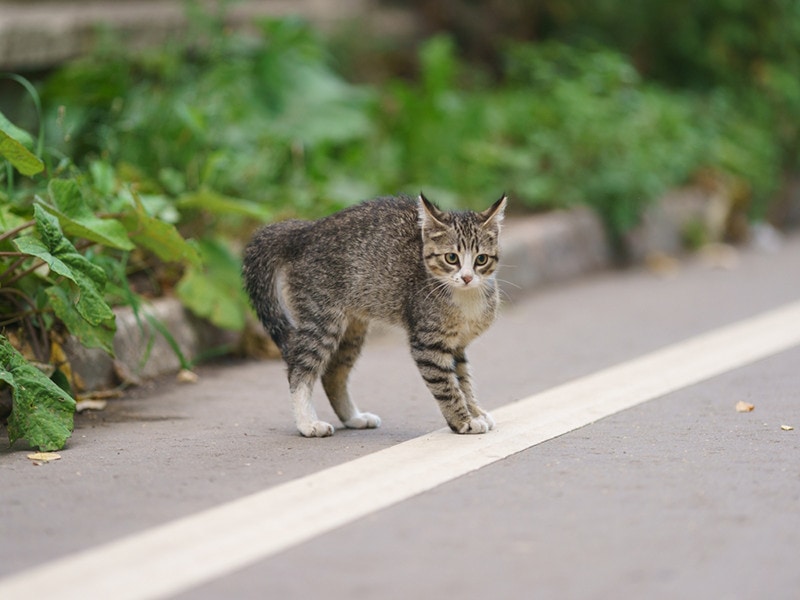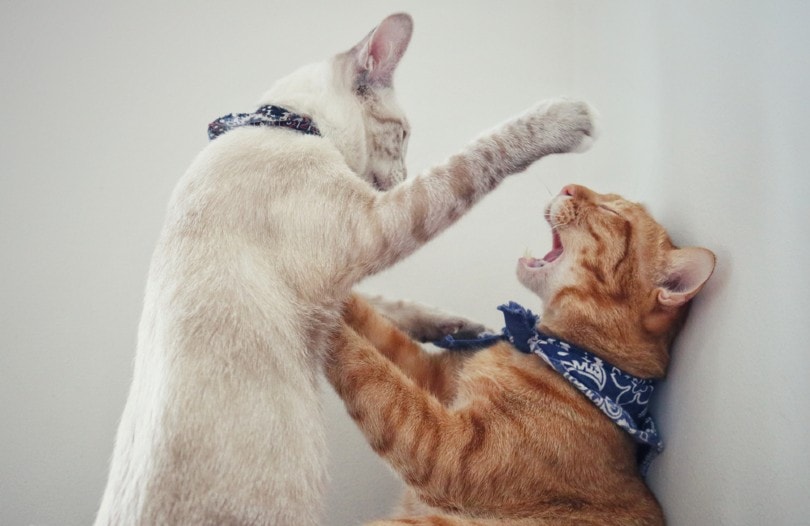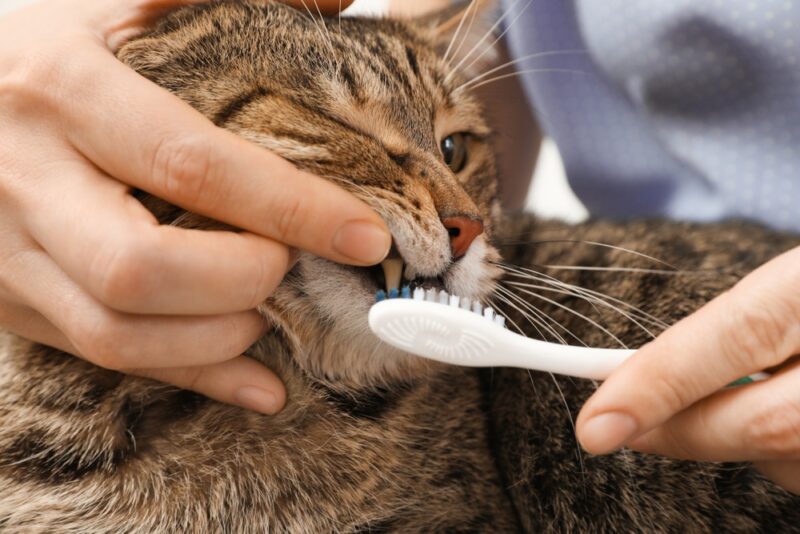We’ve all been there. You’re relaxed, petting your cat, when they suddenly turn and scratch, bite, or swat at you. It may seem unprovoked, but often, cats give subtle signs that they’re about to attack before it escalates.
Below, learn how to detect a cat attack with these common signs of impending aggression, also known as precursors, as well as some tips to prevent it.

The 4 Signs a Cat Might Attack
Detecting a cat attack in advance can be difficult because they communicate using non-verbal methods. However, it can be easier to prevent the attack once you know what to look for and how to identify some of the precursory signs.
1. Body Language Signs
Cats use a lot of body language to communicate. Their moods and feelings are often shown in subtle, rapid movements from their eyes, ears, tail, and posture. Cats feeling aggressive or overstimulated may get a rush of adrenaline, leading their pupils to dilate. They may flatten their ears as a warning and stiffen their tail. Serious aggression often comes out in a “bottle-brush” tail and swishes back and forth.

2. Vocalization
Cats can be pretty vocal, especially when they’re angry or annoyed. Purring, chirping, and other sounds may be used for different purposes, but growling and hissing are nearly always used to create some distance, which, if not respected, will end up in aggression. Hissing comes more from fear and mimics a snake hissing to scare off a larger threat (which may be you), while growling is a more assertive sound that can warn a possible attacker.
3. Physical Aggression
Cats, like people, dogs, and other animals, warn and slowly escalate in aggression. However, if a cat’s subtle warnings are repeatedly ignored, they may jump to physical aggression with a shorter escalation period. This may be a pounce or swat, but some cats may go right to scratching or biting without much warning.

4. Chemical Signals
Cats use pheromones, oils from scent glands, and urine to communicate. They rub on objects to establish their territory and spray urine as a signal to other cats. While you can’t detect any of these chemical cues—save for the strong smell of urine—repeated behaviors to claim territory can indicate that your cat feels stressed and possessive over their space. Aggression is more likely to occur if your cat is stressed.

Types of Cat Aggression
Aggression can arise for many reasons, and it’s crucial to understand what’s triggering the aggression to correct it.
Defensive aggression is when your cat feels victimized, whether by you or another pet. These cats will show more passive body language to protect themselves or warn away the attacker, such as crouching down, tucking their tail, or hissing and raising their hair to intimidate.

Offensive aggression is when the cat is the attacker, which shows in more assertive body language and behaviors. Cats may growl, block doorways or litter boxes, swat, swish their tail, or attack at will.
Aside from defensive and offensive aggression, several types of aggression occur in different situations:
- Play aggression: Cats that haven’t been taught to play appropriately may get too aroused during playtime, leading to excessive biting or scratching humans or household pets.
- Territorial aggression: Cats establish their territory in your home, so they may become aggressive if a new human or pet ventures into their territory.
- Redirected aggression: If your cat feels threatened by something, such as a feral cat outside or loud noises that they can’t attack head-on, they may redirect that pent-up energy with aggression toward you, other family members, or other pets.
- Fear aggression: Cats fearful of new people, animals, or situations may behave aggressively to defend themselves.
- Petting-induced aggression: Cats can become overstimulated by too much touch or when they don’t want it. This can cause aggression.
- Pain-induced aggression: If your cat is in pain, they may react aggressively if you touch the area of their body that hurts.
- Resource-induced aggression: If your cat wants to claim rights to a territory or object in your household, they may fight for it offensively.
- Maternal aggression: Cats that have just given birth may be defensive of their litter, often lashing out at people or pets that they see as threatening to the kittens.

Tips to Prevent Cat Aggression

Preventing cat aggression is always easier than fixing it once it happens. Here are some tips to calm your cat before they escalate to aggressive behaviors:
- Watch for warning signs. Now that you know the cat’s body language preceding attacks, you can take action before your cat bites or scratches. If you see dilated pupils, a swishing tail, or flattened ears, hear a hiss or growl, or notice a generally hostile posture, heed the warning and move away to avoid escalation.
- Redirect aggression (before it happens) with interactive toys or games. It may be enough to break your cat’s focus and divert it to something more positive.
- If you suspect play aggression, include more enrichment activities in your cat’s routine. Interactive playtime, leashed walks, or time in an outdoor catio can help your cat wear out their body and mind, so they’re less likely to lash out.
- Don’t use force. Cats that are forced to be held, cuddled, or petted are more likely to become stressed and lash out. Allow your cat to have control over your touch interactions.
- Don’t play rough, especially with kittens. Teaching your cat to play inappropriately can quickly lead to physical aggression.
- Don’t use physical punishment. Hitting your cat, spraying them with water, or yelling will only create a more hostile environment, giving your cat reason to believe they need to defend themselves.
- Consult an expert if your cat’s attacks are escalating or causing injuries. A cat behaviorist or vet can help you identify the cause of the aggression and curb the behavior. Depending on your cat, medications may be involved to help with behavioral modification.
Pay attention to sudden behavioral changes, including new aggressive behaviors, which can be due to a new stress trigger, medical problems, or hormonal changes. Always investigate new behaviors with a vet to rule out medical issues.
If you need to speak with a vet but can't get to one, head over to PangoVet. It's an online service where you can talk to a vet online and get the advice you need for your pet — all at an affordable price!


Conclusion
Cat aggression can be unsettling at best and dangerous at worst. There are many possible reasons for cat aggression, but preventing the behavior is much easier than correcting it once it escalates. Learn the signs of a cat attack and take steps to prevent it. Over time, your cat may realize that they can relax and don’t need to be on the defensive.
See Also:
- Signs of Aggression in Cats: Vet-Reviewed Behavior Problems to Watch For
- Why Is My Cat Attacking The Mailman
Featured Image Credit by: Astrid Gast, Shutterstock


















